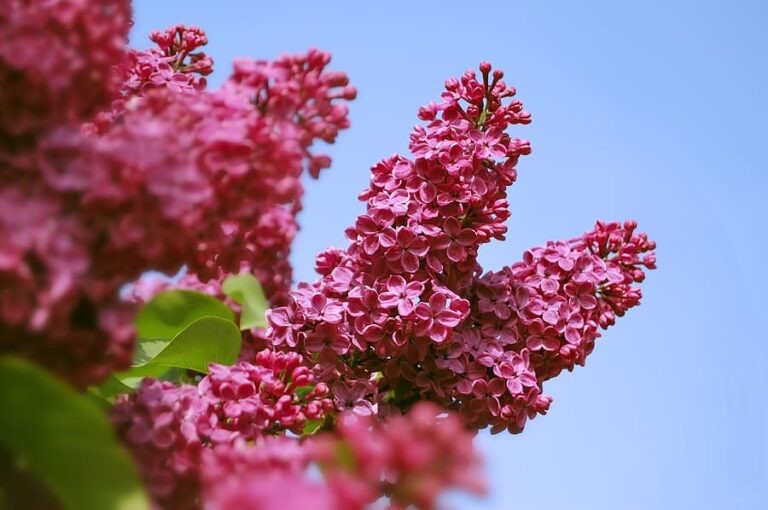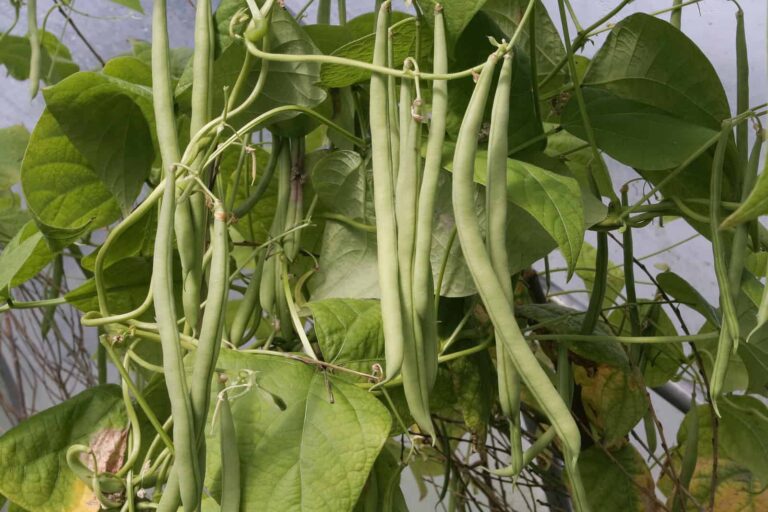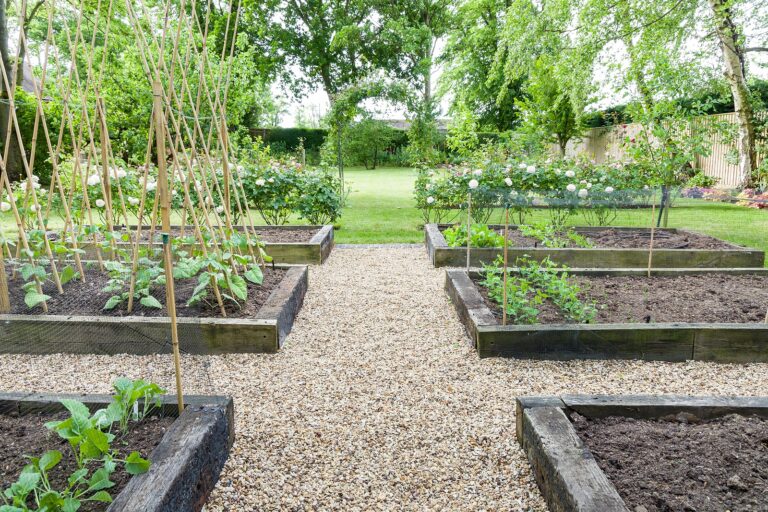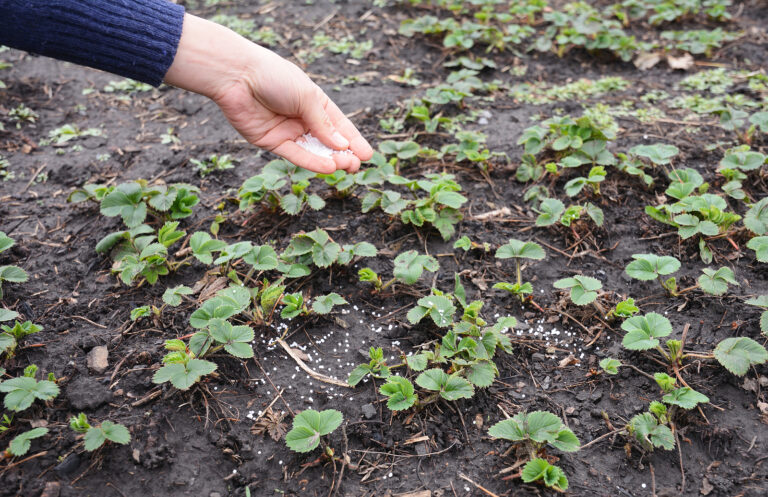First and Last Frost Dates and the Garden Growing Season
The last frost date in spring and the first frost date in autumn mark the beginning and end of the natural garden growing season. Use these dates to plan seed starting, transplanting, and harvesting.
The time to plant seeds in the garden or start seeds indoors depends on the plants you want to grow and their tolerance to frost. The average date of the last frost in your region can be used to determine when a crop can be planted outdoors, or started indoors.
Visit the Winter Garden and Season Extension Learning Hub
The average date of the last frost in spring and the number of days in the growing season before the first frost in autumn are important starting points when sowing seeds indoors or out.
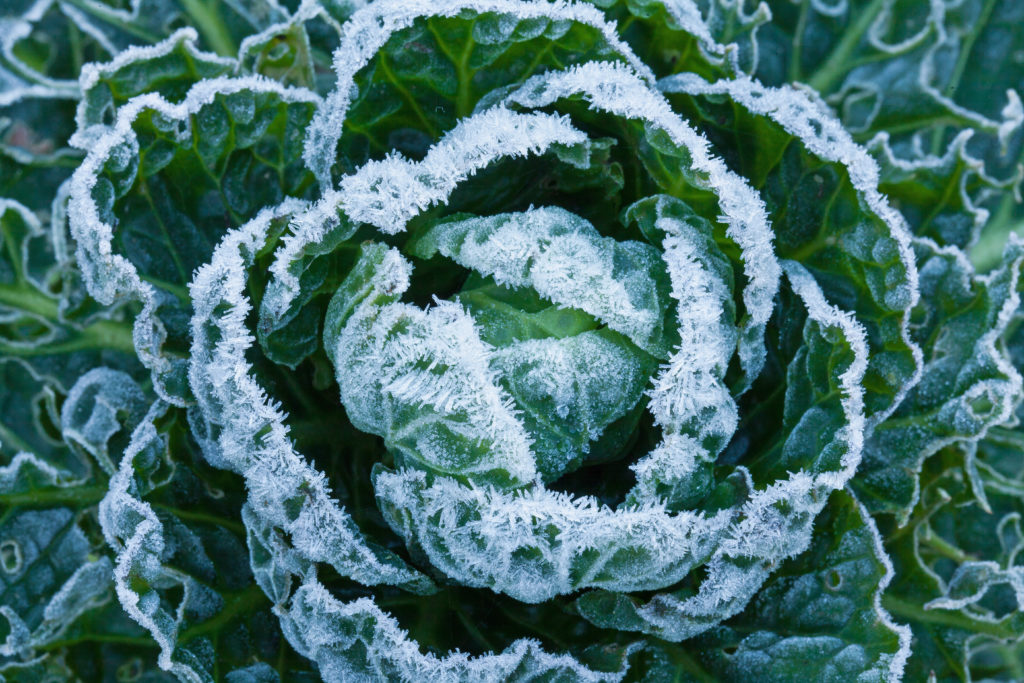
Cool-season crops grow best in the cool weather of spring and autumn–near the frost dates. Warm-weather crops grow best in the late spring and summer months well after the last frost and before the first frost.
Seed starting should be matched to the appropriate time that the variety you are planting will grow. The goal is to bring plants to harvest when the temperatures are optimal to complete their growth cycle or ripen fruit. Planting and harvesting are commonly determined by the number of days between the last frost in spring and the first frost in autumn–this period is known as the growing season.
The average date of the last frost
The average date of the last frost in spring is a day around which you can plan to start seeds indoors, sow seeds in the garden, and set transplants into the garden.
The average date of the last frost in your garden or region is an approximation. It is a date based on an average of the last frost date for each of the last 30 or so years. It is an average or approximation – a date that will change from year to year depending on the weather.
The average date of the last frost is important because most warm-weather plants will not grow and many will die if they are hit by frost. Warm-weather plants most often succeed when they go into the garden two or three weeks after the last frost. By that time daytime temperatures have begun to significantly warm above freezing.
Most cool-weather plants can withstand a light frost. They can be started in the garden a week or two before the last frost in spring or on the date of the last frost in spring.
The average date of the last frost in spring for your regions is available from the nearest cooperative extension. You will also find the last frost date in many gardening books or online from The National Climatic Data Center of the United States government which produces a freeze-frost probability table for each state and the largest cities and towns in each state, and from Weather.com which produces a chart of high and low-temperature averages by month broken out by zip code and city name.
Know the length of the growing season
The length of the growing season in a garden or region is most often expressed as the average number of frost-free days between the last frost in spring and the first frost or hard freeze in autumn. By the date of the last frost in spring, daytime temperatures have grown significantly warmer than freezing.
A more useful measure of the growing season might be soil temperature averages: the date in spring when the soil temperature averages 40°F or greater (when cool-weather plants begin growth) and the last date in autumn when the soil temperature drops below 40°F (when cool-weather plants stop growth).
Soil temperature in spring may lag by days and weeks behind the air temperature as the soil and collected soil moisture warm after the winter chill. (Soil temperature is affected by solar heat, air temperature, and soil moisture.) The soil generally cools more slowly in autumn for the same reasons (residual solar heat remains in the soil from the summer season and the soil is generally drier in autumn than in spring).
The true growing season for a region or garden is the total number of consecutive days that the soil is warm enough to grow plants–including germination, maturation, and ripening before a killing frost or freeze. Minimum soil temperature is required for a plant to germinate and grow; minimum soil and air temperature is required for growth; the flowering temperature (required for fruiting vegetables) will be higher than the minimum growth temperature.
Use the length of the growing season in your garden to set planting dates for early, mid-season, and late-season crops. Use the length of the growing season to plan succession crops; cool-weather spring crops, followed by warm-weather summer crops, followed by cool-weather autumn crops. If you grow crops without protecting them from killing temperatures, your growing season will be determined by nature.
You can get more from your garden by protecting plants and giving them an artificially warm environment in which to grow. This is called growing season extension.
Keep the following growing season information in mind:
- Cool-weather vegetables require a minimum average soil temperature of 40° to 50°F for planting and an average air temperature range of 60° to 85°F (optimal is 70°F) for sustained growth. The maximum air temperature for cool-weather crop productivity is 86°F, above this temperature cool-weather crops will bolt or quit growing.
- Warm-weather vegetables require a minimum average soil temperature of 50°F for planting and an average minimum air temperature of 75°F for sustained growth. The maximum air temperature for warm-weather crop productivity is 110°F, above this temperature most warm-weather crops will die, just as they are likely to die at 32°F.
- Temperature affects a plant’s rate of growth. The higher the soil and air temperature above the minimum, the faster a plant will grow.
- Plant growth time: two-thirds of the growth time necessary for a plant to reach harvest and maturity should be at or above the optimal air temperature; the remaining one-third should be between the minimum and optimal temperature.

Predicting frost in the garden
Frost in the garden happens when the surfaces of plant leaves or fruit—or other solid objects in the garden—are colder than freezing and moisture in the air condenses on the surfaces to form ice crystals. A light frost or white frost happens when the air temperature drops to around 32°F. If you know frost is coming, you can protect plants with plant blankets, floating row covers, plastic tunnels, or even a cardboard box set over the top of plants.
Three signs frost is likely
- The night is clear and bright stars are easily visible. (Clouds act as a blanket of protection against frost keeping ground warmth from escaping into the night.)
- The air is dry before midnight with no condensation on car windows or outdoor furniture. (Moisture in the air releases heat when it condenses to form dew; this will prevent frost from forming if the air temperature is just above 32°F–but will result in frost when the air temperature drops below freezing.)
- The temperature is 45°F or colder by 10 p.m. (You can expect the overnight temperatures to continue to drop and be the coldest just before dawn.)
Protecting plants from frost
Plants under a solid surface such as cloth, plastic, or cardboard—or under the overhand of a building–are less likely to be damaged by a light frost. Cold air is dense; its molecules are tightly packed. Cold air will sink or flow to the lowest point it can, but it cannot move through solid surfaces. (For tips on protecting plants from frost and freezing weather click here to read Season Extension articles.)
Reviving plants hit by frost
Sprinkle plants touched by frost with water from the hose before the sun shines on them. Heat in the water will raise the air temperature around plants and the temperature of plant tissue. After a frost, don’t assume damaged plants are dead. Let plants sit for a week, then remove only tissue that is clearly dead. Leave perennials alone until their normal period of growth begins, then prune out dead plants. In many areas, the first frost is followed by days of warmer weather. It is worth the effort to get plants past the first cold snap; there may be more harvest to come before the first solid freeze. For a list of crops that can survive frost click her to read Vegetable Garden Plant Hardiness.
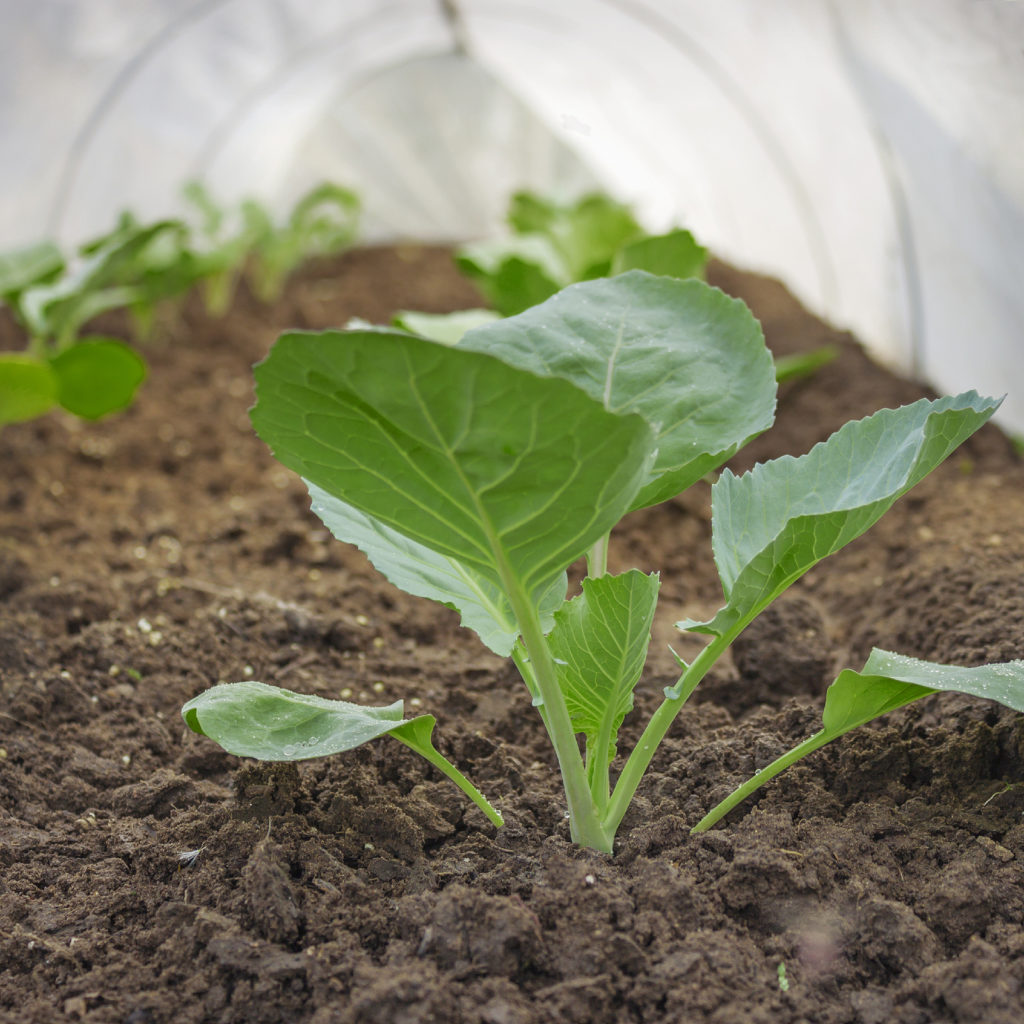
How to extend the growing season
When soil and air temperatures fall below the average and minimum for growing, you can extend the growing season by protecting plants from cold and wind (the combination of wind and low temperatures can be lethal to plants) and by keeping soil and air temperatures at or near the temperatures required for growing. This is achieved with cloches, plastic tunnels, cold frames, hotbeds, and greenhouses. Conversely, when temperatures rise too high for growth, moderate the temperature and protect plants with shade structures, shade cloth, and additional water.
Season extending options
- Use inexpensive plant covers to thwart frost (these will raise the temperature by 2° to 3°F): paper bags with bottoms cut out; cardboard boxes turned upside down; milk cartons or plastic jugs with the bottoms cut out; buckets turned over; hats made of newspaper.
- Use more substantial covers can raise the covered temperature by 5° to 15°F:
- Vertical tomato wire cages wrapped in plastic.
- • Wooden A-frames covered with sheets of polyethylene.
- • Fencing or chicken wire arched across planting beds to form tunnels covered with plastic and held in place with staples or clothespins.
- Arched panels of ribbed translucent fiberglass.
- Hoop or wicket tunnels covering an entire bed: wickets or hoops of stiff wire arched and covered with clear polyethylene.
- Cold frames and hotbeds. A cold frame or hotbed can raise the temperature of protected beds by 20°F or more and extend the growing season by several months to all year. A cold frame or hotbed is a box with a plastic or glass top that captures the warming rays of the sun and holds the heat.
- Use 2 x 8 or 2x 10-inch board to form an open-bottomed box that will fit over your crops. (The top can be made less expensively with two layers of polyethylene.) Cut one end of the box to slant towards the sun, or place soil under the north end of the box so that it slants towards the sun and captures the solar heat.
- A hotbed is a heated cold frame. Dig a pit 18 inches deep and place fresh horse or cow manure in the pit or freshly cut grass or green manure. Place one inch of sand and 6 inches of soil over the organic matter to make a growing bed, or two inches of sand to form a floor on which to place pots or growing flats. The bacterial action of the organic matter decomposition will heat the frame. A hot frame also can be heated by placing light bulbs in the frame or soil heating cables.
- On warm sunny days, air temperature in cold frames, hotbeds, and under plastic tunnels can quickly become too hot. Ventilation–simply opening the top or lifting the cover–is required to keep plants from suffering from too much heat.
Nearly all forms of plant protection can increase the number of growing days by at least three or four weeks in both spring and autumn. That is a significant boost to the growing season. The combination of the extended growing season and higher temperatures will allow the growing of semi-tropical vegetables such as tomatoes, peppers, and eggplants.
How to use last and first frost dates
Average frost dates–the last frost in spring and the first frost in autumn–can be used to set seed starting dates for the crops you plan to grow. They can also be used to set harvest dates and to plan the extension of the growing season–both early and late.
Most crops grow best during the frost-free days of the year. The days between the last frost in spring and the first frost in autumn make up the growing season. The growing season differs from region to region–longer in southern regions, and shorter in northern regions.
The average date of the last and first frost allows you to estimate the length of your growing season. You can use the average date of the last and first frost to plan when seeds can be started in the garden when seeds should be started earlier indoors, and when seedlings started indoors can be set out in the open garden. Since most vegetables and herbs suffer when hit by frost, the average date of the last and first frost is very important.
The average dates of the last and first frost are estimates. They are based on historical averages, average dates kept by weather services, and state and federal agriculture agencies. These averages are commonly used as guidelines for planting and harvesting. Climate, weather, and growing season days can change from year to year so also averages can only be used to approximate when to plant or harvest.
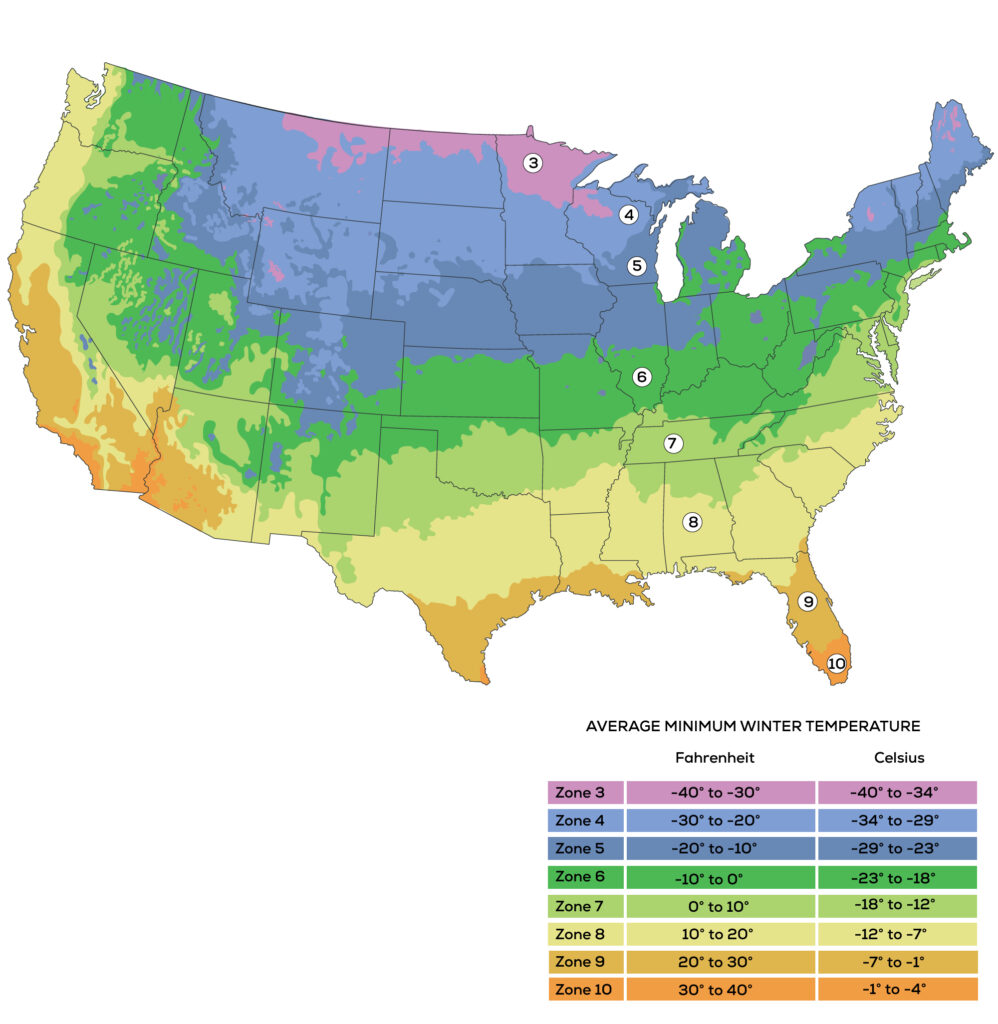
USDA hardiness zones
In addition to the last and first average frost dates, hardiness zones are helpful to gardeners.
A plant’s “hardiness” generally refers to its ability to survive winter temperatures. A plant that is considered hardy in Florida but cannot withstand winter low temperatures in Maine is not hardy to Maine. Hardiness zones were developed to help gardeners determine which plants can survive the minimum temperatures of a particular region.
Plant hardiness zones have been developed by the United States Department of Agriculture. There are 11 growing zones in the United States, zones 1-11. Zone 1 in Alaska has the coldest annual minimum temperatures (lows below -50°F) and Zone 11 in South Florida (lows above 40°F) is the warmest. Hardiness zones are further divided into “A” and “B”; “A” is the less warm region of the zone and “B” is the warmer region of the zone.
You can use last and first frost dates to help determine when the best time to plant a crop. You can use hardiness zones to know how cold a place can get and which plants can survive there. There is an indirect correlation between the average frost dates and hardiness zones.
Other growing factors
Successful growing is also determined by the garden soil type, rainfall or irrigation, daytime temperature, nighttime temperature, day length, wind, humidity, and heat. Climates and growing conditions can vary even if they are in the same growing zone. Use the zones as a starting point, not as the final determinant of what will grow in your garden.
Average first and last frost dates by state and city
Here are the average last frost dates, average first frost dates, average days in the growing season, and USDA zone for several cities in the United States, Canada, and other parts of the world.
United States
State and city Last frost First frost Days Zone
Alabama
Birmingham March 19 November 14 241 7B
Mobile February 17 December 12 298 8A
Montgomery February 27 December 3 279 8A
Alaska
Anchorage May 18 September 13 118 4
Barrow June 27 July 5 8 4
Cordova May 10 October 2 145 4
Fairbanks May 24 August 29 97 4
Arizona
Flagstaff June 8 October 2 116 5B
Phoenix January 27 December 11 317 9A
Tucson March 12 November 21 225 8A
Winslow April 28 October 21 176 5B
Arkansas
Fort Smith March 23 November 9 231 8B
Little Rock March 16 November 15 244 7A
Pine Bluff March 26 November 5 224 7B
Texarkana March 21 November 19 233 7B
California
Bakersfield February 14 November 28 287 8B
Eureka March 10 November 18 253 8B
Fresno February 3 December 3 303 8A
Los Angeles January 3 December 28 359 10
Marysville February 21 November 21 273 7B
Palm Springs January 8 December 18 334 9B
Pasadena February 3 December 13 313 9B
Red Bluff March 6 December 5 274 7B
Riverside March 6 November 26 265 8B
Sacramento January 24 December 11 321 8B
San Diego no frost no frost 365 10
San Francisco January 7 December 29 356 8B
San Jose February 10 January 6 299 8B
Santa Barbara January 22 December 19 331 8B Santa Rosa April 10 November 3 207 8B
Colorado
Denver May 2 October 14 165 5A
Grand Junction April 20 October 9 173 6A
Pueblo April 28 October 12 167 5B
Connecticut
Bridgeport April 26 October 16 174 6A
Hartford April 22 October 19 180 5A
New Haven April 15 October 25 193 6A
Delaware
Dover April 17 October 22 188 7A
Newark April 20 October 17 180 7A
Wilmington April 18 October 26 191 7A
District of Columbia
Washington April 10 October 28 200 9A
Florida
Jacksonville February 6 December 16 313 8B
Miami irregular frost irregular frost 365 10
Orlando January 31 December 17 319 9B
Tallahassee February 26 December 3 280 8B
Tampa January 10 December 26 349 9A
Georgia
Atlanta March 20 November 19 244 7B
Augusta March 14 November 1 249 7B
Macon March 12 November 19 252 7B
Savannah February 21 December 9 291 8B
Hawaii
Hilo no frost no frost 365 10 `
Honolulu no frost no frost 365 10
Idaho
Boise April 29 October 16 171 6A
Coeur d’Alene May 12 October 14 155 5B
Pocatello May 8 September 20 155 4
Illinois
Cairo March 23 November 11 233 6A
Chicago April 19 October 28 192 5B
Rockford May 7 October 11 157 5A
Springfield April 8 October 30 205 5B
Urbana April 22 October 20 151 5B
Indiana
Evansville April 2 November 4 216 6A
Fort Wayne April 24 October 20 179 5B
Indianapolis April 17 October 27 193 5B
Iowa
Des Moines April 20 October 19 183 5A
Dubuque April 19 October 19 184 5A
Mason City April 25 September 25 153 4
Sioux City April 27 October 13 169 4
Kansas
Concordia April 16 October 24 191 5B
Topeka April 9 October 26 200 5B
Wichita April 5 November 11 210 6A
Kentucky
Lexington April 13 October 28 198 6A
Louisville April 1 November 7 220 6B
Louisiana
Lake Charles February 18 December 6 291 8B
New Orleans February 13 December 12 302 9A
Shreveport March 1 November 27 272 8A
Maine
Bangor May 1 October 4 156 5A
Caribou May 19 September 21 125 4
Greenville May 27 September 20 116 5A
Portland April 29 October 15 169 5A
Presque Isle May 31 September 18 110 4
Maryland
Baltimore March 28 November 17 234 7A
Cumberland May 1 October 10 163 6A
Salisbury April 20 October 20 183 7A
Massachusetts
Amherst May 12 September 19 130 5B
Boston April 16 October 25 192 6A
Fall River April 22 October 23 184 6A
Nantucket April 12 November 16 219 6A
Pittsfield May 12 September 27 138 5B
Worcester May 7 October 2 148 5B
Michigan
Detroit April 25 October 23 181 5B
Escanaba May 14 October 6 145 4
Grand Rapids April 25 October 30 190 5B
Lansing May 6 October 8 155 5B
Marquette May 13 October 19 159 4
Minnesota
Albert Lea May 3 October 6 156 4
Duluth May 22 September 24 125 3
Minneapolis April 30 October 13 166 4
Virginia May 29 September 14 108 3
Mississippi
Biloxi February 22 November 28 279 8B
Jackson March 10 November 13 248 7B
Tupelo March 31 October 28 211 7B
Vicksburg March 8 November 15 252 7B
Missouri
Columbia April 9 October 24 198 5B
Kansas City April 5 October 31 210 5B
Saint Joseph April 11 October 14 186 5B
St. Louis April 2 November 8 220 5B
Springfield April 13 October 20 190 6A
Montana
Billings May 15 September 24 132 4
Glasgow May 19 September 20 124 3
Great Falls May 9 September 25 139 4
Havre May 9 September 23 138 4
Nebraska
Lincoln April 20 October 17 180 5A
Norfolk May 4 October 3 152 5A
North Platte April 30 October 7 160 5A
Omaha April 14 October 20 189 5A
Nevada
Elko June 6 September 3 89 5A
Las Vegas March 13 November 13 245 7A
Reno May 14 October 2 141 5B
New Hampshire
Berlin May 29 September 15 109 4
Concord May 11 October 1 143 5A
Errol June 1 September 5 96 4
New Jersey
Atlantic City March 31 November 11 225 6B
Cape May April 4 November 13 222 6B
New Brunswick April 21 October 19 179 6A
Newark April 3 November 8 219 6A
Trenton April 8 November 5 211 6B
New Mexico
Albuquerque April 16 October 29 196 7A
Roswell April 9 November 2 208 7A
Santa Fe April 23 October 19 179 5A
New York
Albany April 27 October 13 169 5A
Binghamton May 4 October 6 154 5A
Buffalo April 29 October 23 178 5B
New York City April 7 November 12 219 6B
Syracuse April 30 October 15 168 5A
Watertown May 7 October 4 151 5A
North Carolina
Asheville April 12 October 24 195 7A
Charlotte March 21 November 15 239 7B
Raleigh March 24 November 16 237 7B
Wilmington March 15 November 19 274 7B
Winston Salem April 14 October 24 193 7A
North Dakota
Bismarck May 11 September 24 136 4
Fargo May 13 September 27 137 4
Williston May 14 September 23 132 3
Ohio
Cincinnati April 15 October 25 192 6A
Cleveland April 21 November 2 195 5B
Columbus April 17 October 30 196 5B
Dayton April 20 October 21 184 5B
Toledo April 24 October 25 184 5B
Oklahoma
Miami April 7 October 26 202 6A
Oklahoma City March 28 November 7 223 7A
Tulsa March 31 November 2 216 6B
Oregon
Bend June 8 September 7 91 5B
Eugene April 13 November 4 205 7B
Medford April 25 October 20 178 7B
Portland February 25 December 1 279 8A
Salem April 14 October 27 197 7B
Pennsylvania
Altoona May 6 October 4 151 5B
Erie May 1 October 11 163 5A
Harrisburg April 10 October 28 201 6A
Philadelphia March 30 November 17 232 6B
Pittsburgh April 20 October 23 187 6A
Scranton April 24 October 14 174 5B
Williamsport May 3 October 13 164 5B
Rhode Island
Kingston May 1 October 14 166 6A
Providence April 13 October 27 197 6A
South Carolina
Charleston February 19 December 10 294 8A
Columbia March 14 November 21 252 7B
Greenville March 23 November 17 239 7B
South Dakota
Huron May 4 September 30 149 5A
Rapid City May 7 October 4 150 5A
Sioux Falls May 5 October 3 152 5A
Tennessee
Chattanooga March 26 November 11 229 7A
Knoxville March 31 November 6 220 6B
Memphis March 20 November 12 237 7A
Nashville March 28 November 7 224 6B
Texas
Brownsville February 15 December 10 298 9A
Corpus Christi January 26 December 27 335 9A
Dallas March 18 November 22 249 8A
El Paso March 26 November 14 238 8B
Houston February 5 December 11 309 8B
Lubbock April 1 November 9 205 7A
Plainview April 10 November 6 211 7B
Utah
Blanding May 18 October 14 148 6B
Logan May 15 October 6 144 6B
Ogden April 13 October 22 192 6B
Salt Lake City April 12 November 1 202 6B
Vermont
Bennington May 15 October 4 142 5A
Burlington May 8 October 3 148 4
St. Johnsbury May 22 September 25 126 3
Virginia
Norfolk March 18 November 27 254 7B
Richmond April 2 November 8 220 7A
Roanoke April 20 October 24 187 7A
Washington
Centralia April 27 October 7 173 7B
Seattle February 23 December 1 281 7B
Spokane April 20 October 12 175 5B
Walla Walla April 3 November 1 211 5B
Yakima April 15 October 22 190 6A
West Virginia
Charleston April 18 October 28 193 6B
Martinsburg April 29 October 16 170 6B
Parkersburg April 16 October 21 189 6A
Wisconsin
Green Bay May 6 October 13 161 5A
Lacrosse May 1 October 8 161 4
Madison April 26 October 19 177 5A
Milwaukee April 20 October 25 188 5B
Wyoming
Casper May 18 September 25 130 4
Cheyenne May 20 September 27 130 4
Sheridan May 21 September 21 123 4
Puerto Rico
All locations no frost no frost 365 10
Virgin Islands
All locations no frost no frost 365 10
Canada
Alberta
Calgary May 28 September 9 104 3
Edmonton May 14 September 14 123 3
British Columbia
Prince George June 10 August 28 79 3
Victoria February 28 December 9 284 7B
Manitoba
Churchill June 26 September 12 82 2
Winnipeg May 25 September 21 119 3
New Brunswick
Fredericton May 18 September 26 130 4
Newfoundland
Saint John’s June 3 October 12 131 5A
Northwest Territories
Yellow Knife May 30 September 16 109 2
Nova Scotia
Halifax May 15 October 15 153 5B
Ontario
Toronto April 20 October 30 193 5B
Prince Edward Island
Charlottetown May 17 October 15 151 5A
Quebec
Montreal May 3 October 17 155 4
Quebec City May 18 September 18 123 4
Saskatchewan
Regina May 27 September 12 108 5B
Yukon
Dawson May 26 August 27 93 4
Growing Zones throughout the World
Country and city Zone Minimum
Argentina
Buenos Aires 9
Cordoba 9
Australia
Adelaide 10 Australia zone 4
Brisbane 10 Australia zone 4
Melbourne 10 Australia zone 4
Perth 10 Australia zone 4
Sydney 10 Australia zone 4
Austria
Vienna 6
Belgium
Brussels 8
Chile
Santiago 10
China
Beijing 7
Hong Kong 10
Shanghai 9
France
Lyon 8
Paris 8
Marseille 9
Germany
Berlin 6
Frankfurt 7
Hamburg 7
Munich 6
Ireland
Belfast 9
Dublin 8
Galway 9
Italy
Florence 9
Milan 8
Palermo 10
Rome 9
Venice 8
Japan
Sapporo 6
Kyoto 9
Tokyo 9
New Zealand
Auckland 10
Christchurch 9
Wellington 10
South Africa
Cape Town 11
Durban 11
Johannesburg 9
Spain
Barcelona 10
Cordoba 9
Madrid 9
Seville 10
Valencia 10
United Kingdom
Bristol 9
Glasgow 8
Inverness 8
Leeds 8
Liverpool 9
London 8
Uruguay
Montevideo 10
Garden Planning Books at Amazon:


